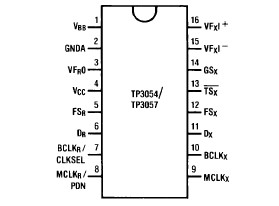TP3057-X: Features: `−40°C to +85°C operation`Complete CODEC and filtering system (COMBO) including:- Transmit high-pass and low-pass filtering- Receive low-pass filter with sin x/x correction- Active R...
floor Price/Ceiling Price
- Part Number:
- TP3057-X
- Supply Ability:
- 5000
Price Break
- Qty
- 1~5000
- Unit Price
- Negotiable
- Processing time
- 15 Days
SeekIC Buyer Protection PLUS - newly updated for 2013!
- Escrow Protection.
- Guaranteed refunds.
- Secure payments.
- Learn more >>
Month Sales
268 Transactions
Payment Methods
All payment methods are secure and covered by SeekIC Buyer Protection PLUS.

 TP3057-X Data Sheet
TP3057-X Data Sheet







